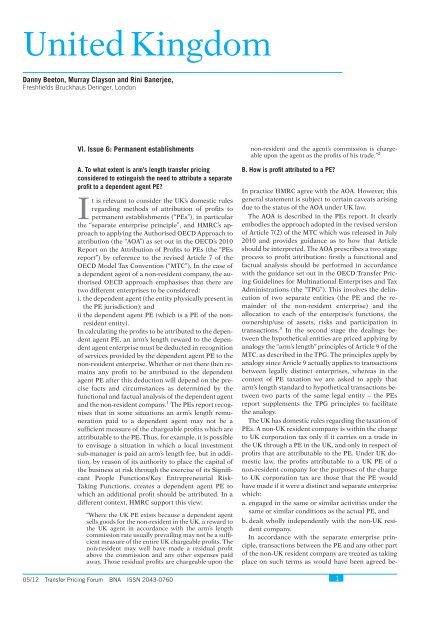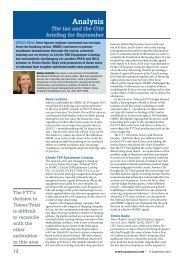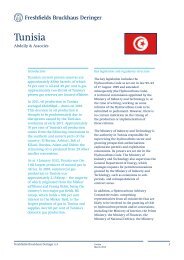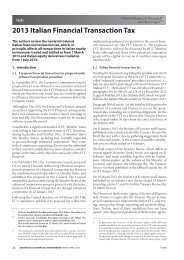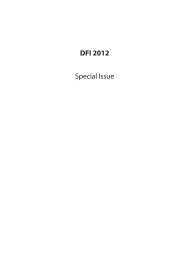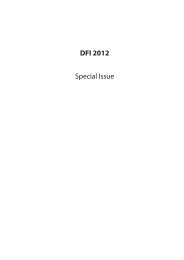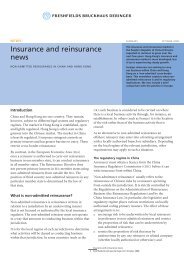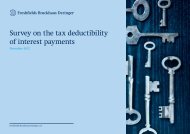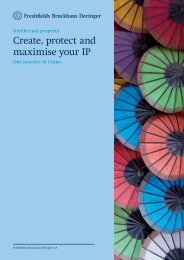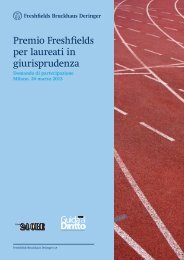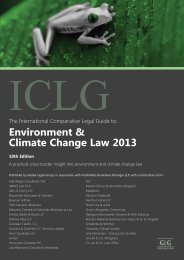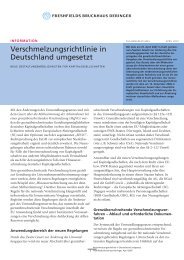XPP-PDF Support Utility - Freshfields
XPP-PDF Support Utility - Freshfields
XPP-PDF Support Utility - Freshfields
You also want an ePaper? Increase the reach of your titles
YUMPU automatically turns print PDFs into web optimized ePapers that Google loves.
terest’’ need not be recognised. . .the ban on deductionsfor internal debts and receivables shouldcontinue to apply generally’’. However, paragraphs 43to 48 described a different treatment for ‘‘the deductionof interest on debts actually incurred by the enterprise’’(paragraph 43), which was clearly permissible.There is no relevant reference to interest in the revisedCommentary; and the PEs report does not refer to ‘‘internaldebts’’ but rather to the calculation of an interestexpense commensurate with the non-’’free’’ capitalwhich a PE is deemed to require in order to finance itsassets and risks. The previous version of the Commentaryset a limit equal to the total external borrowing ofthe company of which the PE was a part (see Part Iparagraph 117 of the PEs Report).E. Can a PE pay a royalty to its head office?INTM267100 states that:‘‘CTA09/S31 specifically prohibits a deduction to a PEfor ‘intra-entity’ payments for the use of intangibleassets, e.g. trade or brand names or any other intellectualproperty. This means that where such a paymentis purported to be made by the PE to any other part ofthe non-resident company of which it is a PE theamount cannot be allowed in calculating the profitsattributable to the PE. The only circumstances whenpayments for the use of intangible assets can be allowedto the PE are where the entity as a whole has incurredsuch a payment to an external party and thepayment was wholly or partly in respect of the PEbusiness. For example, the non-resident companypays royalties under a licence agreement to use particularsoftware that is employed in the business carriedout through the UK PE. As with any otherexpenses incurred, where the expenses are less thanentirely in respect of the PE’s business the expensemay be apportioned on a reasonable basis.’’UK domestic law is consistent with the previous versionof the Commentary on Article 7. Paragraph 34 ofthe previous version of the Commentary stated that‘‘[s]ince there is only one legal entity it is not possibleto allocate legal ownership to any particular part ofthe enterprise’’. The Commentary went on to explainthat it would therefore be appropriate for the costs ofcreating or acquiring an intangible to be allocated betweenthe various parts of the enterprise (without aprofit mark-up) and with no royalty being imputed.The previous version of the Commentary therefore didnot permit notional royalties to be imputed. However,there appears to be no prohibition in the previous versionof the Commentary on attributing, to a PE, partof an expense in respect of royalties paid to a thirdparty (as per the old paragraph 3 of the Article, and explainedas being a wider ranging expenses attributionconcept in paragraph 27 of the previous version of theCommentary). There is no relevant mention of royaltiesin the revised Commentary but as noted above inthe context of services, the revised Commentarypoints us to the PEs report. Part I paragraph 201 ofthe report notes that it is sometimes appropriate toview the PE and its head office as having participatedin a Cost Contribution Arrangement (CCA) (in whichcase no notional royalty should be imputed). Paragraphs203-204 also note that no internal royaltyshould be imputed where the functional analysis indicatesthat the reward for the intangible would havebeen included in the price of goods or in a profit split.However, paragraph 203 explains that the intangible‘‘owner’’ (as determined by the functional analysis)may be deemed to have received a royalty and that‘‘the recognition of the notional royalty is relevant.. .to the attribution of profits to the PE’’. Thisappears to be a break with the previous version of theCommentary which has not been reflected in UK domestictax law. However, paragraph 30 of the Commentaryobserves that once the profits attributable toa PE have been determined under Article 7(2), it is forthe domestic law of each state to determine whetherand how such profits are taxed as long as there is conformitywith Article 7(3) and the other provisions ofthe relevant treaty. Also, domestic rules that preventthe deduction of certain categories of expenses are notaffected by Article 7(2).Vll. Issue 7: Intra-group servicesA. When can services be charged for at cost?HMRC, at INTM463050 and INTM466080, explainthat when functions performed by the enterpriseamount to a service, or involve intra-group services,then the cost plus basis is usually appropriate. Thelevel of the plus depends on the nature and complexityof the service.Services can be charged at cost when it would seemthat the arrangements made in relation to the testedtransaction do not differ from those which wouldhave been agreed between comparable independentparties and that these would involve charging at cost.In order to conclude that arrangements do not differfrom what would have been agreed between comparableindependent parties, the contractual arrangements,or those indicated by the actual conduct of theparties where the latter differs, will be considered.HMRC would have also regard to the TPG which atparagraph 7.33 state that:‘‘. . .there are circumstances. . .in which an independententerprise may not realise a profit from the performanceof service activities alone, for examplewhere a supplier’s costs (anticipated or actual) exceedmarket price but the supplier agrees to provide the serviceto increase its profitability, perhaps by complementingits range of activities. Therefore, it need notalways be the case that an arm’s length price will resultin a profit for an associated enterprise that is performingan intra-group service’’. Paragraph 7.34 of the TPGgoes on to explain that this could occur ‘‘where, for example,the service is not an ordinary or recurrent activityof the service provider but is offered incidentallyas a convenience to the MNE 6 group. . .[an] MNEgroup may still determine to provide the service intragrouprather than using a third party for a variety ofreasons, perhaps because of other intra-group benefits.’’The TPG also note that the cost of third party servicesshould be charged on to related parties with noprofit mark-up, where an associated enterprise isacting ‘‘only as an agent or intermediary’’ in the provisionof services. The mark-up should then only beadded to the cost of performing the agency function(ibid., paragraph 7.36).Another situation in which HMRC would acceptthat no profit mark-up need be added to costs is thatof a CCA, as addressed in Chapter VIII of the TPG. As3 05/12 Copyright 2012 by The Bureau of National Affairs, Inc. TP FORUM ISSN 2043-0760
noted in paragraph 8.3 of the TPG, a CCA is ‘‘a frameworkagreed upon by business enterprises to share-. . .costs. . .’’, not to provide services to each other. InINTM463090 HMRC note that ‘‘[a] CCA may be distinguishedfrom [an intra-group services arrangement]through the concept of mutual benefit and the sharingof contributions to that activity in proportion to thebenefits each participant expects to obtain.’’B. Is there any special treatment for ‘‘low value’’services?HMRC explain in INTM466080 that in cases involvingthe provision of services, one needs to considerwhether the services are ‘‘low-level, auxiliary and inthe nature of services that might be contracted out byindependents’’. In the event that they are, then a costplus method might not be appropriate. Beyond thiscomment and the discussion of charging at cost in theTPG there is no special treatment of ‘‘low value’’ servicesin the UK.C. Are any safe harbours available for services?There are no UK safe harbours for services (or in factfor any aspects of transfer pricing).D. What evidence is required of benefits received?INTM464050 explains that a review of the evidenceshould indicate what price would be charged betweenindependents for the service. HMRC explain that awhole range of commercial factors would influencethe price, including:s the costs of providing the service;s the costs of an alternative;s the expected benefit;s the state of the market; ands the financial position of the provider or recipient.Clearly, an analysis of benefit received is required inorder to determine an arm’s length price.Paragraph 7.32 of the TPG, to which HMRC wouldrefer, notes that ‘‘it may be helpful to perform a functionalanalysis of the various members of the group toestablish the relationship between the relevant servicesand the members’ activities and performance. Inaddition, it may be necessary to consider not only theimmediate impact of a service, but also its long termeffect. . .’’Vlll. Issue 8: Functional analysisA. To what extent is it sufficient to analyse a single‘‘tested party’’ or must both parties or the whole supplychain be analysed?HMRC’s approach would be consistent with the TPGwhich at paragraph 3.20, for example, states that‘‘. . .one-sided methods. . .only require examining a financialindicator or profit level indicator for one ofthe parties to the transaction (the ‘tested party’. . .)’’.However, even in these cases, HMRC would wish tosee information on both parties to a transaction sothat it can confirm that Step 3 of the ‘‘typical[comparability analysis] process’’ set out at paragraph3.4 of the TPG has been carried out correctly. Thisparagraph states that this will be necessary in order togain an ‘‘understanding of the controlled transactions(s)under examination, based in particular on afunctional analysis, in order to choose the tested party(where needed), the most appropriate transfer pricingmethod in the circumstances of the case, the financialindicator that will be tested (in the case of a transactionalprofit method), and to identify the significantcomparability factors that should be taken into account.’’B. To what extent are the results of the functionalanalysis used to adjust price benchmarks?As demonstrated in the case of DSG Retail Limited vRevenue & Customs Commissioners (‘‘DSG’’), HMRCwill expect all of the ‘‘factors determining comparability’’described at paragraphs 1.38 to 1.63 of the TPG tobe taken into account in the comparability analysis,namely the characteristics of the property or services,the functional analysis, the contractual terms, the economiccircumstances and the business strategies.lX. Issue 9: ComparablesA. Are secret comparables used?INTM467110 explains that an enquiry should not bedependent on secret comparables:‘‘. . .[HMRC] holds a detailed breakdown of accountsfor every company in the UK, and generally a goodamount of detail about the business activities ofmedium, large and very large companies. Given a sufficientamount of time, an [HMRC] Officer couldprobably find either a comparable transaction or agood set of comparable companies.This informationis not available to the taxpayer. The OECD TransferPricing Guidelines do not sanction the use of hiddencomparables and so you should not use informationthat is only available to HMRC.You can object to the use of particular companies presentedas comparables from the results of a search ofa commercial database, if you hold information thatsuggests conclusively that the company is not actuallycomparable. You cannot tell the taxpayer why itshouldn’t be used, unless the information you hold isactually within the public domain but was not available(or was unknown to the researcher) at the timethe comparable search was being made. . .In practice, from the facts available to both HMRCand the taxpayer, it should be possible to consider thearm’s length price.’’B. Are the results of non-independent companiesreferred to as benchmarks?HMRC will follow the clear definition in paragraph3.24 of the TPG that ‘‘[a] comparable uncontrolledtransaction between two independent parties. . .canbe either a comparable transaction between one partyto the controlled transaction and an independent party.. .or between two independent enterprises, neitherof which is a party to the controlled transaction. . .’’This clearly excludes transactions between relatedparties.05/12 Transfer Pricing Forum BNA ISSN 2043-0760 4
C. How comparable do comparables need to be?INTM467090 makes clear that Part 2 of TIOPA 2010must be construed in accordance with OECD principles.The foundation position in the UK is that thearm’s length standard should be applied on atransaction-by-transaction basis. Often, however, it ispracticable to depart from this ideal, and HMRC believethat a ‘‘sensible, pragmatic approach should beadopted’’ which ensures that one is comparing likewith like. The most likely situations are described inINTM467090 as follows:s ‘‘When using the transactional net margin method(‘‘TNMM’’) you are comparing the results, margins,return on capital, etc. of different companies. Theactual intra-group transactions will be contained inthe results of the company that is being tested. Sowhile you can’t compare the actual transactions,you compare results, etc., which are based in parton those transactions.s When goods or services are acquired under a longtermcontract it is good practice to evaluate theprice of that contract rather than the individualtransactions. Similarly if goods or services are acquiredon terms that are effectively rolled over eachtime there is a purchase, then it makes sense to considerall the purchases as a whole. Rememberthough there is a difference in goods supplied undera long term contract and goods supplied on a transactionby transaction basis. Each situation has itsown different risks that need to be addressed.s When goods or services are acquired under a licenceagreement, the terms of the licence agreementshould be considered as well as the purchasesunder that contract.s Some goods are very similar or closely linked andare often referred to as a basket of products. Providedthe various goods have very similar attributes,costs of production, costs of marketingand sale price, then the goods can be considered asa whole.s In the case of the licensing of manufacturing knowhowand the supply of vital components to an associatedmanufacturer, it is likely to be morereasonable to consider the pricing of the know-howand components as a package.s Where a transaction is routed through another associatedcompany, it may be more appropriate toconsider whether this particular transaction formspart of an integrated series of transactions, whichshould be compared as a whole.’’HMRC believe that the best source of comparableswill be within the group itself (see INTM467100). Alarge group will have contracts and trading relationshipswith many customers, suppliers, contractors,etc. Comparing the prices, terms and conditions oftransactions with affiliates with the prices, terms andconditions of transactions with independents will providea source of comparables. However, INTM467100explains that a search for internal comparables issometimes overlooked by groups when they are consideringtheir transfer pricing policy and compilingdocumentation to demonstrate that the pricing is atarm’s length. If the transfer pricing documentationmakes no mention of internal comparables, the companyshould establish what work has actually beendone to find out if there are any.Where a group has considered internal comparables,one will need to examine carefully why transactionshave been discarded as not being similarenough, or whether the work carried out has beenthorough enough. Even with adjustments, internalcomparables are likely to provide better evidence thanthe net margins of other third party companies.HMRC generally believe that UK comparablesshould be compared first. However, ‘‘if there are noUK comparables, or the UK comparable companiesput forward are flawed in some way, then it may benecessary to consider using comparables in othercountries.’’ The aim is to ‘‘compare like with like’’. Thisposition is explained in further detail in INTM467120.HMRC provide guidance in INTM467140 on levelsat which transactions may be compared, according tothe following scale:s ‘‘Comparing a single transaction, e.g. the sale price,and terms of sale of a particular product.s Comparing a bundle of transactions, e.g. a licenceagreement, a contract for services, a distributionagreement, etc.s Comparing results of independent companies at thegross margin level.s Comparing results of independent companies at thenet margin level.s Comparing results of independent companies byreference to some other measure, such as return oncapital, ratio of costs to gross margin, etc.’’The TPG recognise that slight differences betweencompanies can be adjusted for. However, it is unlikelythat significant differences can be taken into accountin a meaningful manner. HMRC agree with the OECDapproach and INTM467140 provides some detail, asfollows, on when adjustment of comparables is possibleand how to achieve such adjustment:s ‘‘It is difficult to compare cases on the basis of capitalemployed as this presupposes that the testedparty has a capital structure you will find at arm’slength. If the tested party is part of a group this is afalse premise and making adjustments is difficult. Itis easier to make adjustments when comparingreturn on assets.s The information needed to make adjustments isgoing to be limited. Commercial databases provideonly the information that is publicly available. Youwill find little in the way of breakdown of profit andloss entries for example.s Keep adjustments as simple as possible. If youthink that a detailed economic formula is needed,using multiple variables, then you are very likelytrying to do too much. Similarly, be sceptical oflarge numbers of very detailed adjustments; youmay well find that the adjusted comparables bearlittle resemblance to what they started out life as.s Consider carefully any adjustments that seek toturn independent comparable transactions or companyresults into some strange hybrid which youwould be very unlikely to find in the commercialworld.s Some adjustments will be based on balance sheetfigures, for example stock and trade debtors. Thesefigures are snap shots and may not be representa-5 05/12 Copyright 2012 by The Bureau of National Affairs, Inc. TP FORUM ISSN 2043-0760
tive for the whole year, particularly if the trade issubject to seasonal variations.s Adjustments can only be taken so far before anycomparison is rendered meaningless. Consider a setof comparable companies showing a range of netmargins between three and five percent; aftermaking adjustments, the range is zero to three percent.Any exercise where the adjustment or series ofadjustments significantly alters the range of pricesor results is liable to be flawed.’’Some of the more common adjustments are foundin stock/cost of sales, trade debtors/sales and costs relatingto a particular function that is not carried outby some of the comparables or the tested party.The last bullet point above indicates a considerableresistance of HMRC to large comparability adjustments,and a preference instead for observations thatare much more comparable in their unadjusted form.INTM467150 states that ‘‘[i]t does not matter if youcan only find one company that is carrying on virtuallythe same activities as your company. . .[a] rangeof results from two good comparables is much betterthan a range encompassing two good and twelve mediocrecomparables’’. HMRC’s focus is therefore verymuch on close comparability rather than on a minimumnumber of comparables.Issue 10: Specific industriesA. Are there certain industries that are significant inyour economy and which influence the general approachto transfer pricing?The financial services industry is relatively large in theUK and to some extent has special transfer pricingrules, as explained below, but this has not influencedHMRC’s general approach to transfer pricing. HMRChave a relatively high interest in sectors in which intangibleproperty figures significantly, such as pharmaceuticalsand life sciences, and these will beparticularly affected by the Patent Box which is due totake effect from April 1, 2013, and involves transferpricing calculations.B. Do they face any special transfer pricing rules?It is possible to identify specific transfer pricingframeworks within the UK financial services industry,as described in the following sections.1. Investment managementBy virtue of a long-standing statutory concession tothe UK financial services industry, profits arising toforeign investors (‘‘non-residents’’, each a ‘‘nonresident’’)through a UK investment manager in respectof ‘‘investment transactions’’ are exempt fromtax, save in respect of any deductions which are madeat source. There are two policy objectives underlyingthis exemption. These objectives are that overseas investorsshould not be charged to UK tax in relation toinvestment transactions conducted on their behalfand that any fees earned by a UK resident investmentmanager for services performed for the non-residentshould be fully chargeable to UK tax.For this exemption (referred to as ‘‘the investmentmanager’s exemption’’, ‘‘IME’’) to apply, there are severalconditions which must be satisfied. One such conditionis that the remuneration which the managerreceives for the provision to the non-residents of theinvestment management services in question is at arate that is not less than that which would have been‘‘customary’’ for that person or class of business.In a statement of practice published in 2007 (the‘‘SoP’’), HMRC confirmed that they will apply thearm’s length principle when determining whether apricing structure applies the customary rate. The SoPconfirms that, in determining whether remunerationhas been reduced below the arm’s length rate in anyway, HMRC will consider both the remuneration receivedby the UK investment manager and anyamounts payable to any person (whether payable bythe non-resident or the UK investment manager):s for services provided to the non-resident; ors in connection with the non-resident; ors that relate to the performance of the non-resident.Any such amounts (which may, for example relateto contracted out administration services or to subadvisoryservices) will be treated as reducing the remunerationreceived in the UK below the customaryrate unless they can also be shown to be at an arm’slength rate. In order to demonstrate to HMRC that remunerationis at an arm’s length rate, the investmentmanager should have sufficient transfer pricing documentationin place at the time of making a return. Inpractice, this will consist of records, along with atransfer pricing report setting out the functionalanalysis and applying an acceptable transfer pricingmethodology.If this supporting documentation is in place at thetime of making a return, the investment manager willhave the opportunity to agree any adjustments whichmay be requested to meet the customary rate, or ifagreement is not possible, to have adjustments determinedby the courts, in each case without being consideredto have failed the ‘‘customary rate’’ test. Ifdocumentation is not in place however, HMRC statethat ‘‘it may be that the customary test is not met’’. Inthese circumstances, the non-resident will potentiallybe exposed to tax and HMRC may notify the nonresidentand its agents of its intention to take action inrelation to the non-compliance, unless the nonresidentand the investment manager are able to agreeimmediate remedial measures with HMRC.Give the importance to UK investment managersand their offshore clients of fulfilling the conditionsfor qualifying for the IME, including meeting the ‘‘customaryrate’’ test, transfer pricing methodology isrelatively well developed in relation to the pricing ofinvestment management services and a body of datafor comparable fees is available to transfer pricingpractitioners. As regards investment management andsub-investment management, it would be typical tosee services remunerated by a service fee calculatedusing the comparable uncontrolled price (‘‘CUP’’)methodology, adjusted where relevant for the cost ofcapital provided by, for example, the holding company.A fee calculated on the basis of the CUP model isalso frequently used to calculate the commission payablein respect of sales and marketing functions,05/12 Transfer Pricing Forum BNA ISSN 2043-0760 6
whilst routine back-office functions will generally becalculated on a cost-plus basis.2. Insurance premiumsThe HMRC guidance does not specifically discuss theuse of transfer pricing methods in the allocation of insurancepremiums but HMRC are required to haveregard to the general approach to transfer pricingmethodology stated in the TPG when interpreting domestictransfer pricing rules. Whilst the TPG do notspecifically refer to the discussion of the allocation ofprofits to permanent establishments of insurancecompanies set out in Part IV of the PEs report, Part IVof the PEs report can nevertheless be expected to be asource of guidance for HMRC.Therefore as regards the underwriting and riskmanagement functions, it could generally be expectedthat the allocation of insurance premiums wouldclosely follow the allocation of risk; to the extent thatunderwriting and risk management functions are integratedand performed in more than one location,profit split methods may be applied to allocate insurancepremiums between locations.The PEs report suggests that, as regards asset management,credit analysis and claims administrationfunctions, external comparators (i.e. CUPs) are likelyto be relatively easily found and therefore it would beunnecessary to apply other methods. In relation toother functions, such as sales and marketing andproduct development, the extent to which an uncontrolledcomparator exists elsewhere will depend onthe complexity of those functions and the degree towhich those functions impact on the assumption ofrisk (for example, through input into structuring).Given the emphasis on the CUP method in the HMRCguidance, it is likely that HMRC would apply a similarapproach.DSG is so far the only case in which issues on transferpricing methodologies and the application of theTPG have been considered in detail. Whilst DSG isgenerally supportive of the emphasis placed by thePEs report upon the attribution of insurance premiumsaccording to the assumption of insurance risk,taking into account the need to attribute commensuratesurplus capital to that risk, the decision of thecourt also highlights a number of other factors whichare relevant in applying transfer pricing methodologyin the insurance and/or reinsurance context, in particularas regards captive (re)insurance entities.The taxpayer that was the subject of the dispute inDSG was Dixons Stores Group (‘‘DSG’’), which hadbeen dominant in the UK domestic electrical goodsmarket for a number of years. DSG concerned twosets of arrangements related to the profitable ‘‘extendedwarranty’’ business that was conducted inDSG’s retail outlets: a customer buying an electricalappliance would, at the point of sale, be invited to purchasean extended warranty covering repair or replacementfor a period of years beyond the normalmanufacturer’s warranty.Under the first set of arrangements, insurancebackedpolicies written by a third party insurer weresold to customers in DSG stores. The insurer largelyperformed a ‘fronting’ role as it had entered into a reinsurancecontract for 95 percent of the risk with aDSG subsidiary (‘‘DISL’’), which was an Isle of Manresident company not itself authorised to write insurancein the UK.The second set of arrangements resulted from an increasein the rate of Insurance Premium Tax (‘‘IPT’’)announced in late 1996. From April 1997 customers ofDSG stores purchased warranty service contracts(rather than anything which amounted to insurance)with a newly formed Isle of Man company owned bythird parties. This company contracted with DISL toinsure the contracts, this time for 100 percent of therisk.Under both sets of arrangements a sales agent companywould sell contracts to customers through DSG’sstores in the UK, receiving an initial sales commissionand passing on net premiums (or, under the second arrangement,‘‘warranty fees’’) to the third party, whichceded those premiums (or warranty fees) to DISLunder the reinsurance (or under the second example,insurance) arrangements. The contractual arrangementsalso provided for subsequent profit commissionsto be paid from DISL back through the relevantthird party entity to DSG, which had the effect of cappingthe profits of both DISL and the relevant thirdparty. Under both sets of arrangements DISL retainedthe investment income on its surplus cash, which,over time, exceeded the underwriting profit itself.HMRC attacked the arrangements on the basis thatDSG had provided DISL with the opportunity to enterinto profitable contracts and that those contracts werenot on arm’s length terms. In response, DSG adducedevidence derived from potentially comparable transactions,which DSG claimed should form the basis foran application of the CUP method. HMRC contendedthat those comparables did not provide sufficientguidance for an application of the CUP method and,therefore, it was necessary to apply the profit splitmethod.The court rejected each of the various comparablesproposed by DSG, either as a fundamentally unsuitablecomparator or as one for which appropriate adjustmentscould not be made, particularly as regardsinequality of bargaining power, which resulted principallyfrom DSG’s point of sale advantage, but alsofrom:s the low cost to DSG of putting together a deal withan alternative insurer or switching insurers at alater date;s DSG’s access to data on past claims in the market(which would otherwise have been a source of bargainingpower for DISL); ands the fact that DSG, as a market leader, had no needfor an external brand.It followed that the CUP method was unavailable.The court agreed with HMRC that a profit splitmethod was apt and that the suitable method was onewhich tested the appropriate return on capital withthe residual profit accruing to DSG because the profitsof the arrangement as a whole arose primarily becauseof DSG’s point of sale advantage as a retailer.Accordingly, a formulaic application of the ‘‘capitalasset pricing model’’ was proposed as a reasonable approachto calculating DISL’s cost of capital, to betreated as a supplemental profit commission payableby DISL to DSG. The court considered that the modelcould be adjusted for a short time following the7 05/12 Copyright 2012 by The Bureau of National Affairs, Inc. TP FORUM ISSN 2043-0760
group’s structural response to the increase in the IPTrate to take into account that DISL would have someadditional short-term bargaining power, as thegroup’s existing reinsurer, to negotiate more favourableterms.DSG is notable for the court’s departure from theCUP method, but also for the court’s clear emphasisthat the difference in bargaining power between thetwo parties was critical to the question of what wouldhave been agreed between the two parties at arm’slength. Whilst this may seem an obvious point, it hassignificant implications as regards captive insuranceor reinsurance companies, which (particularly at apoint at which the relationship is well established anddata regarding loss ratios is known) can be expectedto have a relatively weak bargaining position as regardstheir parent company. Therefore, whilst thecourt in DSG stated the ‘‘exceptional’’ nature of thefacts of the case because, provided that the loss ratiowas within certain bounds, the underwriting profit ofthe third party insurer and DISL was set, this decisioncould be expected to have implications for captive insuranceor reinsurance entities more generally.3. Banks and insurance companiesWith respect to banking, the relevant HMRC guidancestates that: ‘‘[w]here there has in fact been a capital allotmentbased on the economic and regulatory requirementsof the PE’s business, any tax adjustmentunder the new legislation is likely to be relativelyminor, taking into account that allotment. Where,however, the UK PE’s business is not supported, or isinadequately supported, by capital, the purpose of theUK legislation is to make an adjustment to the UK taxcomputation to align the taxable profits more closelywith those which would be achieved by similar bankingactivities carried out by a UK bank in the same orsimilar circumstances’’. The adjustment described inthis quote is referred to as the ‘‘capital attribution taxadjustment’’ (the ‘‘CATA’’).In relation to the CATA, HMRC guidance suggeststhat a useful step-by-step way by which tax inspectorscan structure their approach in determining whetherany adjustment is required (and if so, in whatamount) is as follows:i. determine the assets attributable to the PE;ii. risk weight those assets;iii. determine the equity capital that the PE would requireif it were a distinct and separate enterpriseengaged in the same or similar activities under thesame or similar conditions;iv. determine the loan capital that such an enterprisewould have had if it had the equity capital determinedunder step (iii); andv. determine the capital attribution tax adjustment tobe made, based on the difference between the PE’sactual funding costs on the combined amount representingthe equity and loan capital determinedunder steps (iii) and (iv) and the notional fundingcosts (which will include a rate of nil in respect ofthe equity capital) to be taken into account in accordancewith domestic legislation.This recommended five-step analysis therefore requiresan application of the factual and functionaltransfer pricing analysis (as described above in relationto the attribution of profits), along with an applicationof (generally) UK regulatory rules indetermining how capital would have been required tobe allocated to the PE.The HMRC guidance also suggests that, unless theactivities carried on by the PE are sufficiently differentfrom those carried on by the bank as a whole (thatis, either inherently riskier or less risky), it may bepossible to apply the capital ratios of the bank to thePE rather than applying the five-step approach describedabove. As a second alternative to the five-stepapproach, the HMRC guidance suggests that an analysisbased on UK banking comparables may be used,although it cautions that it may be difficult to find‘‘true comparables’’ in the banking context (in terms ofsize and spread of activities) and therefore suggeststhat the use of comparables might prove to be mosthelpful as a check where capital has been attributed tothe PE based on the capital mix of the company as awhole.Section 32 CTA 2009 contains provisions disallowingdeductions for payments of interest or other financingcosts by a PE to any other part of a non-UKresident company, although the restriction does notapply to the interest or other financing costs that arepayable in respect of the borrowing by the PE in theordinary course of a financial business carried on byit. ‘‘Financial business’’ for these purposes meansbanking, deposit-taking, money lending or debt factoring,or a business similar to these; and dealing incommodity or financial futures.4. Sectors in which IP is importantThis proposed 10 percent Patent Box tax regime forincome attributable to the commercialisation of patentsowned or exclusively licensed by the taxpayer willinvolve:s an assumption that a profit of cost plus 10 percentis earned on routine activities;s the determination (with a small claims exemption)of a notional arm’s length royalty payable for theuse of any marketing intangibles; and, where thepatent is being used to produce non-patented goodsor servicess the determination of an arm’s length royalty for theuse of the patent.Danny Beeton is head of transfer pricing economics at<strong>Freshfields</strong> Bruckhaus Deringer LLP in London and may becontacted by email at danny.beeton@freshfields.comMurray Clayson is a partner in <strong>Freshfields</strong> Bruckhaus DeringerLLP’s tax practice group in London and may be contacted byemail at murray.clayson@freshfields.comRini Banerjee is a trainee solicitor at <strong>Freshfields</strong> BruckhausDeringer LLP in London and may be contacted by email atrini.banerjee@freshfields.comNOTES1 See Part I of the PEs report at Section D-5(ii) (paragraph270.2See HMRC’s International Manual (‘‘INTM’’) atINTM276040.3 This is a functional rather than a legal analysis since thePE does not itself legally enter into transactions or ownassets in its own right, separate from the rest of the nonresidententity: see Part I of the PEs report at SectionB-3(i) (paragraphs 13 – 15).05/12 Transfer Pricing Forum BNA ISSN 2043-0760 8
4 Sections 5(2)/(3) and 19, 21 and 22 Corporation Tax Act(‘‘CTA’’) 2009.5 Although there is no express requirement under UK lawto interpret the corporation tax rules applying to PEs ofnon-resident companies consistently with the MTC, section164 of the Taxation (International and Other Provisions)Act 2010 (‘‘TIOPA’’) requires the transfer pricingrules in Part 4 TIOPA to be interpreted in a way so as bestto secure consistency with Article 9 and the TPG, and inpractice HMRC will apply the same approach to attributionof profits to UK PEs: see guidance published byHMRC at INTM267040. HMRC’s manuals are a publicstatement of HMRC’s views on UK domestic law but theyshould be treated with caution since they are unlikely tobind HMRC.6 Multinational Enterprise.9 05/12 Copyright 2012 by The Bureau of National Affairs, Inc. TP FORUM ISSN 2043-0760


